 W
WA band clamp is a generic term for a holding device usually consisting of a strap of metal or cloth formed into a loop, with a mechanism to forcibly adjust the diameter, thereby exerting a squeezing force on an object within the loop.
 W
WThe bark spud is an implement which is used to remove bark from felled timber.
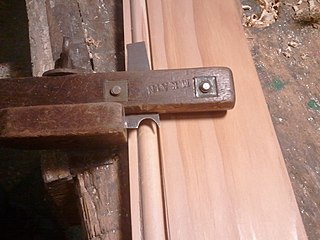 W
WA bead is a woodworking decorative treatment applied to various elements of wooden furniture, boxes and other items.
 W
WBeaver Lumber was a Canadian building supply chain owned by Molson. It was once Canada's fourth largest building supply chain with 138 stores. In 2000 it was purchased by Home Hardware, a cooperative of over 1000 independent Canadian hardware stores. Beaver Lumber stores were rebranded as Home Building Centres.
 W
WGarry Knox Bennett is an American woodworker, furniture maker, metalworker and artist, known for his whimsical, inventive and unconventional uses of materials and designs in his work. His long-established workshop and studio is in Oakland, California.
 W
WBookmatching is the practice of matching two wood or stone surfaces, so that two adjoining surfaces mirror each other, giving the impression of an opened book.
 W
WBowtell is derived from the medieval term bottle; in architecture it refers to a round or corniced molding below the abacus in a Tuscan or Roman Doric capital; the word is a variant of boltel, which is probably the diminutive of bolt, the shaft of an arrow or javelin. A roving bowtell is one which passes up the side of a bench end and round a finial, the term roving being applied to that which follows the line of a curve.
 W
WA bradawl is a woodworking hand tool with a blade similar to that of a straight screwdriver and a handle made from wood or plastic.
 W
WA burnisher is a hand tool used in woodworking for creating a burr on a card scraper.
 W
WA butterfly joint, also called a bow tie, dovetail key, Dutchman joint, or Nakashima joint, is a type of joint or inlay used to hold two or more pieces of woods together. These types of joints are mainly used for aesthetics. But these types of joints can be used to reinforce cracks in pieces of wood, doors, picture frames, or drawers.
 W
WIn the context of furniture, caning is a method of weaving chair seats and other furniture either while building new chairs or in the process of cane chair repair. In common use, "cane" may refer to any plant with a long, thin stem. However, the cane used for furniture is derived from the rattan vine native to Indonesia, the Philippines and Malaysia. The vines typically grow to 100–300 ft in length; most have a diameter less than 1 in. Before export, the rattan stems are cut to uniform lengths and the bark is removed in narrow strips of 1⁄16 to 3⁄16 in. Sugar cane and bamboo should not be confused with rattan cane. Rattan vine looks somewhat similar to bamboo but is quite different in that bamboo is hollow and holds itself upright while rattan is a solid flexible vine that needs the support of surrounding structure to elevate itself off the forest floor. It climbs to the top of canopies of the forest to reach sunlight with the help of large rugged thorns that grab hold of surrounding trees. Sometimes much of the length of these rugged vines are draped along the forest floor from tree to tree in search of a suitable structure to climb.
 W
WIn theatre, a carpenter is a stagehand who builds sets and stage elements. They usually are hired by the production manager, crew chief or technical director and in some less common cases they may be hired by director or producer. They are usually paid by the hour.
 W
WIn architecture and joinery, the chambranle is the border, frame, or ornament, made of stone or wood, that is a component of the three sides round chamber doors, large windows, and chimneys.
 W
WA coated abrasive is an abrasive grain bonded to a flexible substrate using adhesives. Common substrates are paper, cloth, vulcanized fiber, and plastic films and come in grit sizes range from very coarse (~2 mm) to ultrafine (submicrometre). The international standard for coated abrasives is ISO 6344.
 W
WA dado rail, also known as a chair rail or surbase, is a type of moulding fixed horizontally to the wall around the perimeter of a room.
 W
WA dado set or dado blade is a type of circular saw blade, usually used with a table saw or radial arm saw, which is used to cut dadoes or grooves in woodworking. There are two common kinds of dado sets, stacked dado set and wobble blade.
 W
WEdge Banding, or edgebanding, is the name of both a process and an associated narrow strip of material used to create durable and aesthetically pleasing trim edges during finish carpentry.
 W
WAn F-clamp, also known as a bar clamp or speed clamp, is a type of clamp. The name comes from its "F" shape. The F-clamp is similar to a C-clamp in use, but has a wider opening capacity (throat). This tool is used in woodworking while more permanent attachment is being made with screws or glue, or in metalworking to hold pieces together for welding or bolting.
 W
WC. & E. Fein GmbH is a manufacturer of high-end power tools located in Stuttgart, Germany. Founded in 1867 by brothers Wilhelm Emil Fein and Carl Fein, the company invented the hand-held electric drill in 1895 and was responsible for many other innovations. Fein became famous for its grinders, electric screwdrivers, and Fein Multimaster RS.
 W
WA finger plane is a small plane, typically with a brass body, used by luthiers.
 W
WFlame maple , also known as flamed maple, curly maple, ripple maple, fiddleback or tiger stripe, is a feature of maple in which the growth of the wood fibers is distorted in an undulating chatoyant pattern, producing wavy lines known as "flames". This effect is often mistakenly said to be part of the grain of the wood; it is more accurately called "figure", as the distortion is perpendicular to the grain direction. Prized for its beautiful appearance, it is used frequently in the manufacturing of fine furniture and musical instruments, such as violins, guitars, and bassoons.
 W
WFrameless construction in cabinetmaking refers to the construction of cabinets using flat panels of engineered wood — usually particle board, plywood or medium-density fibreboard — rather than the traditional frame and panel construction.
 W
WA framer is someone who frames, or someone who constructs.
 W
WA French cleat is a way of securing a cabinet, mirror, artwork or other object to a wall. It is a molding with a 30–45 degree slope used to hang cabinets or other objects.
 W
WAn insert nut provides a threaded socket for a wooden workpiece, similar to a wall anchor. Insert nuts are inserted into a pre-drilled hole by one of two means: screw in and hammer in. In both cases, the external protrusions bite into the wood, preventing the nut from either turning or pulling out.
 W
WA joiner is an artisan and tradesperson who builds things by joining pieces of wood, particularly lighter and more ornamental work than that done by a carpenter, including furniture and the "fittings" of a house, ship, etc. Joiners may work in a workshop, because the formation of various joints is made easier by the use of non-portable, powered machinery, or on job site. A joiner usually produces items such as interior and exterior doors, windows, stairs, tables, bookshelves, cabinets, furniture, etc. In shipbuilding a marine joiner may work with materials other than wood such as linoleum, fiberglass, hardware, and gaskets.
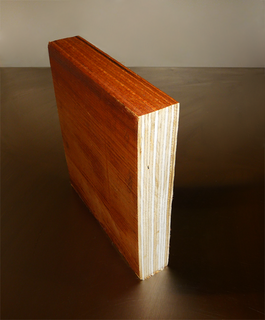 W
WLaminated veneer lumber (LVL) is an engineered wood product that uses multiple layers of thin wood assembled with adhesives. It is typically used for headers, beams, rimboard, and edge-forming material. LVL offers several advantages over typical milled lumber: Made in a factory under controlled specifications, it is stronger, straighter, and more uniform. Due to its composite nature, it is much less likely than conventional lumber to warp, twist, bow, or shrink. LVL is a type of structural composite lumber, comparable to Glued laminated timber (Glulam) but with a higher allowable stress.
 W
WA log house moulder is a machine to prepare logs to be suitable for building a log home. In general, the logs are first sawn to a square beam, then the moulder makes the groove. Often fitted to a portable sawmill that enables direct profiling of round or squared logs. The log house moulder is usually powered by electricity, but for portable sawmills they are sometimes using a chainsaw as power head. One of the more common, especially in Europe, is the Logosol log house moulder.
 W
WMatchboard by definition is "a board with a groove cut along one edge and a tongue along the other so as to fit snugly with the edges of similarly cut boards."
 W
WMitre clamps are designed to hold mitre joints together. The earliest mitre clamps are a simple spring in a C-shape with sharpened points that are sprung onto the outside corner of the mitre joint. The right angled plates are higher than the screws and the red holder. The screws go under the frame (work-piece) to be held, and the red bit clamps down on the lower-edge of the frame. Recent designs are more complicated; a rigid body holds one fixed and one moveable jaw activated by a cam. Examples of the newer clamps are Jim Chestnut's "Clam Clamp" and the Maestro Mitre Clamp.
 W
WIn woodworking, a moulding plane is a specialised plane used for making the complex shapes found in wooden mouldings.
 W
WA plank is timber that is flat, elongated, and rectangular with parallel faces that are higher and longer than wide. Used primarily in carpentry, planks are critical in the construction of ships, houses, bridges, and many other structures. Planks also serve as supports to form shelves and tables.
 W
WPopular Woodworking is a woodworking magazine published by Cruz Bay Publishing an arm of Active Interest Media.
 W
WQuilt or quilted maple refers to a type of figure in maple wood. It is seen on the tangential plane (flat-sawn) and looks like a wavy "quilted" pattern, often similar to ripples on water. The highest quality quilted figure is found in the Western Big Leaf species of maple. It is a distortion of the grain pattern itself. Prized for its beauty, it is used frequently in the manufacturing of musical instruments, especially guitars.
 W
WRichard Raffan is a well-known woodturner, author, and instructor who has helped popularize the craft of woodturning since the 1970s. He was a part of the "art turning" movement that saw turned objects move into galleries where they are presented as works of art. Although he has created large and valuable works of exotic woods, in his books he has also championed simple utilitarian works created for daily use. He finishes much of this work simply, using vegetable oil and beeswax, and has written admiringly of the patina of well used wooden items. "An indescribable surface that begs for a caress of the hand--that's what I think wood should provide."
 W
WA razee plane is a style of wooden hand plane which has a section of it's rear cut away, so that the plane has a lower handle. This design makes the plane lighter, with a lower centre of mass, and puts the handle closer to the workpiece and cutting edge – giving the user greater control.
 W
WIn woodworking and the decorative arts, refinishing refers to the act of repairing or reapplying the wood finishing on an object. In practice, this may apply to the paint or wood finish top coat, lacquer or varnish. The artisan or restorer is traditionally aiming for an improved or restored and renewed finish. Refinishing can apply to a variety of surfaces and materials such as wood, glass, metal, plastic and paint, although in Britain, when referring to wood or wooden furniture it is commonly known as repolishing - short for re-French Polishing.
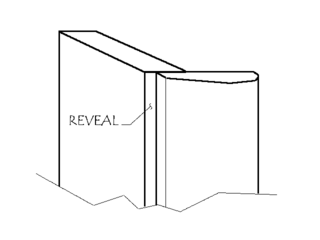 W
WIn carpentry, a reveal is a feature resembling a rabbet, but constructed of separate pieces of wood. A reveal may typically be seen at the edge of a door or window, where the face molding is set back, often by a distance from 3/16" to 1/2" to reveal the edge of the casing plank.
 W
WRoman shades are a type of window covering used to block out the sun. Roman shades are different from standard window shade in that they stack up evenly when being opened; however, when they are open they are visibly smooth, not bumpy or ribbed like typical vertical shades or blinds.
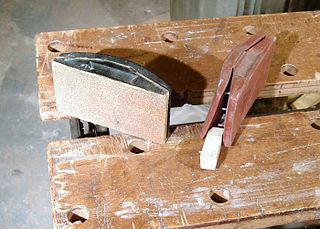 W
WA sanding block is a block used to hold sandpaper. In its simplest form, it is a block of wood or cork with one smooth flat side. The user wraps the sandpaper around the block, and holds it in place.
 W
WA sliding T bevel, also known as a bevel gauge or false square is an adjustable gauge for setting and transferring angles. Different from the square, which is fixed and can only set a 90° angle, the sliding T bevel can set any angle and transfer it on another piece.
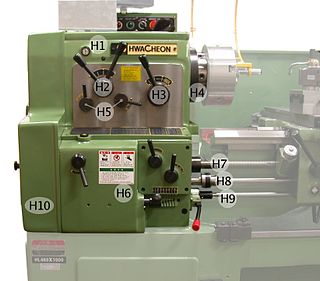 W
WIn machine tools, a spindle is a rotating axis of the machine, which often has a shaft at its heart. The shaft itself is called a spindle, but also, in shop-floor practice, the word often is used metonymically to refer to the entire rotary unit, including not only the shaft itself, but its bearings and anything attached to it.
 W
WA stave is a narrow length of wood with a slightly bevelled edge to form the sides of barrels, tanks, tubs, vats and pipelines, originally handmade by coopers. They have been used in the construction of large holding tanks and penstocks at hydro power developments. They are also used in the construction of certain musical instruments with rounded bodies or backs.
 W
WA steam box is a long, sealed container used to steam wooden planks for the purpose of making them pliable. Once steamed and then fastened or clamped into the desired position and left to dry, the wood will hold the new shape. Steam boxes allow for much more efficient use of wood. Instead of cutting the desired shape away from a large and more expensive piece of wood and leaving much scrap to be discarded, steam boxes allow for a smaller piece to be bent in the general shape and leaving much less scrap. Steam boxes also allow the wood to bend beyond its dry breaking point, which is useful in making extreme curves with the wood. In many cases, the bent piece is stronger than an identical piece cut from larger stock. Steam bending wood allows the wood grain to follow the bend, leaving it strong where a piece cut from larger stock would snap across crosscut grains or laminated joints.
 W
WA stop block is a simple reusable jig used in metalworking and woodworking to locate a common edge of a workpiece so that multiple workpieces can get the same operation performed quickly. Common applications are table saws and manual milling machines, but they are also used on miter saws, band saws, radial arm saws, and abrasive saws.
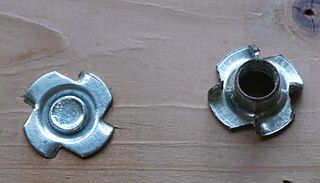 W
WA T-nut, T nut, or tee nut is a type of nut used to fasten a wood, particle or composite materials workpiece, leaving a flush surface.
 W
WA tapering jig is a woodworking jig used to cut a progressively deeper cut along a workpiece usually parallel to the grain.
 W
WA veneer hammer is a woodworking tool used in applying veneer.
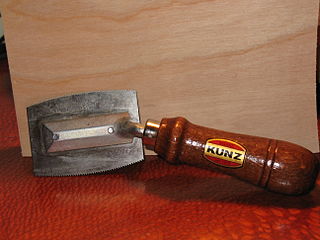 W
WThe veneer saw is a small double-edged tool for cutting thin hardwood veneer. Its narrow curved blade facilitates precision work, and its elevated offset handle makes it possible to cut flush with a surface. The blade is usually 3 or 4 inches long and it has 13 tpi.
 W
WA Warrington hammer is a type of cross-peen hammer commonly used in woodworking. Other names for the Warrington hammer include joiners' hammer, English pattern hammer, and Warrington pattern hammer.
 W
WWood is a magazine catering to the home and hobby woodworker with more than 350,000 subscribers. It publishes seven regular issues annually. It has the highest circulation of any woodworking magazine in the world.